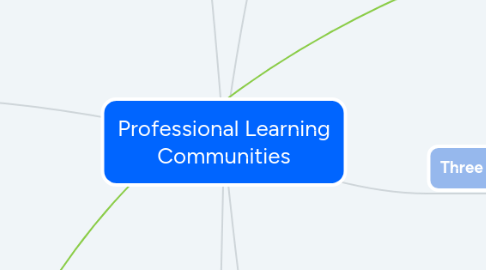
1. Barriers
1.1. Time and structure for meeting (DuFour, 2004).
1.2. Expectation that standards and curriculum determine results (DuFour, 2004).
1.3. Excuses (DuFour, 2004).
1.4. Isolation (DuFour, 2004).
1.5. Resource hoarding (DuFour, 2004).
1.5.1. Ideas
1.5.2. Materials
1.5.3. Strategies
2. Factors for Success
2.1. "A Culture of Collaboration" (DuFour, 2004)
2.1.1. Systems for working together in teams (DuFour, 2004)
2.1.2. Systems to assess and inform classroom practices (DuFour, 2004)
2.1.3. Alignment of behavior plans (DuFour, 2004).
2.2. Team Learning (DuFour, 2004)
2.3. Member persistence and commitment (DuFour, 2004).
2.4. A continuous cycle of examination, questioning, and improvement (DuFour, 2004).
2.5. Sharing
2.5.1. Goals (DuFour, 2004)
2.5.2. Strategies (DuFour, 2004)
2.5.3. Materials (DuFour, 2004)
2.5.4. Pacing (DuFour, 2004)
2.5.5. Questions (DuFour, 2004)
2.5.6. Concerns (DuFour, 2004)
2.5.7. Results (DuFour, 2004)
2.6. Time to Meet
2.7. Protocols
2.7.1. Roles in the PLC (DuFour, 2004).
2.7.2. Responsibilities (DuFour, 2004).
2.7.3. Relationships (DuFour, 2004).
2.8. Accountability for results (DuFour, 2004).
3. Support Student Learning
3.1. "Focus on Results" (DuFour, 2004)
3.1.1. Data-based goal setting (DuFour, 2004).
3.1.2. Student success data (DuFour, 2004).
3.2. Align responses to students not learning (DuFour, 2004).
3.2.1. Responses are
3.2.1.1. "Timely" (DuFour, 2004)
3.2.1.1.1. Teachers identify needs and provide help quickly (DuFour, 2004).
3.2.1.2. Interventions (DuFour, 2004)
3.2.1.2.1. Proactive rather than reactive and remedial (DuFour, 2004).
3.2.1.3. "Directive" (DuFour, 2004)
3.2.1.3.1. Students are required to participate (DuFour, 2004).
3.3. Align learning goals
4. What Are They?
4.1. Group of professionals collaborating in a school or district.
4.2. Eight Key Characteristics (Bolam et al., 2005)
4.2.1. Shared Values and Vision
4.2.2. Collective Responsibility for Student Learning
4.2.2.1. Mission to ensure learning for all (DuFour, 2004).
4.2.3. Collaboration Focused on Learning
4.2.4. Individual and Collective Professional Learning
4.2.5. Reflective Professional Inquiry
4.2.6. Openness, Networks, and Partnerships
4.2.7. Inclusive Membership
4.2.8. Mutual Trust, Respect, and Support
4.3. Collaborate to coordinate strategies (DuFour, 2004).
5. Three Crucial Questions
5.1. "What do we want each student to learn?" (DuFour, 2004)
5.1.1. Standards
5.1.2. Learning Objectives
5.1.2.1. Common Goals
5.1.3. Preparation for the next grade
5.1.3.1. Ask next year's teachers (DuFour, 2004).
5.2. "How will we know when each student has learned it?" (DuFour, 2004)
5.2.1. Assessments
5.2.1.1. Common formative assessments (DuFour, 2004)
5.2.1.1.1. Consistent application of the same criteria (DuFour, 2004).
5.2.1.2. Common Cumulative Assessments (DuFour, 2004).
5.2.2. Data from assessments
5.3. "How will we respond when a student experienced difficulty during learning?" (DuFour, 2004)
5.3.1. RTI
5.3.2. Interventions
5.3.3. Resources
5.3.4. Instructonal Strategies (DuFour, 2004)
